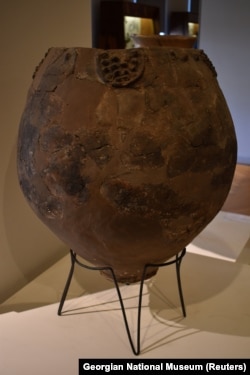The world's earliest evidence of grape winemaking has been detected in 8,000-year-old pottery jars unearthed in Georgia, making the tradition almost 1,000 years older than previously thought, researchers said on November 13.
Previously, the oldest chemical evidence of wine in the Near East dated to 5,400-5,000 BC and was from the Zagros Mountains of Iran, said a report in the Proceedings of the National Academy of Sciences, a U.S. journal.
The world's very first wine is thought to have been made mostly from rice in China around 9,000 years ago, followed by the grape-based alcohol found in Iran. The find in Georgia dates to about 6,000 BC, the researchers said.
"We believe this is the oldest example of the domestication of a wild-growing Eurasian grapevine solely for the production of wine," said co-author Stephen Batiuk, a senior research associate at the University of Toronto.
Georgia, using the same Eurasian grape variety, Vitis vinifera, remains a major wine-growing region today.
"The wine was probably made similarly to the traditional qvevri method in Georgia today, where the grapes are crushed and the fruit, stems, and seeds are all fermented together," Batiuk said.
David Lordkipanidze, director of the Georgian National Museum who helped lead the research, said wines made in Georgia today still use large qvevri jars similar to the ancient ones, which measured 80 centimeters tall and 40 centimeters wide.
The team of researchers hailed from the United States, Canada, Denmark, France, Italy, Israel, and Georgia. They have been working for the past four years to re-analyze archeological sites that were found decades ago.
The fragments of ceramic casks, some decorated with grape motifs and able to hold up to 300 liters, were found at two archaeological sites called Gadachrili Gora and Shulaveris Gora dating from the Neolithic period, about 50 kilometers south of the Georgian capital Tbilisi.
Researchers used a combination of mass spectrometry and chromatography techniques to identify the compounds found in wine in the ancient jar fragments.
Their chemical analysis "confirmed tartaric acid, the fingerprint compound for grape and wine," they said in their report.
Wine 'Central' To Western Civilization
Researchers also found three organic acids associated with wine -- malic, succinic and citric -- in the residue from the jars.
"The Eurasian grapevine that now accounts for 99.9 per cent of wine made in the world today, has its roots in Caucasia," Batiuk said, adding that the domestication of the grape "eventually led to the emergence of a wine culture in the region."
"Alcohol had an important role in societies in the past just as today," he said. "Wine is central to civilization as we know it in the West."
"As a medicine, social lubricant, mind-altering substance, and highly valued commodity, wine became the focus of religious cults, pharmacopoeias, cuisines, economies, and society in the ancient Near East," he said.
But the study's lead author, Patrick McGovern, a scientific director at the Penn Museum in Philadelphia who also co-authored the 1996 Nature study that placed the earliest evidence for grape wine in Iran, said the search for the truly oldest wine artifacts will continue.
"Other sites in the South Caucasus in Armenia and Azerbaijan might eventually produce even earlier evidence for viniculture than Georgia," McGovern said.
"The Taurus Mountains of eastern Turkey are also a prime candidate for further exploration with its monumental sites at Gobekli Tepe and Nevali Cori at the headwaters of the Tigris River," dating as far back as 9,500 BC, he said.















